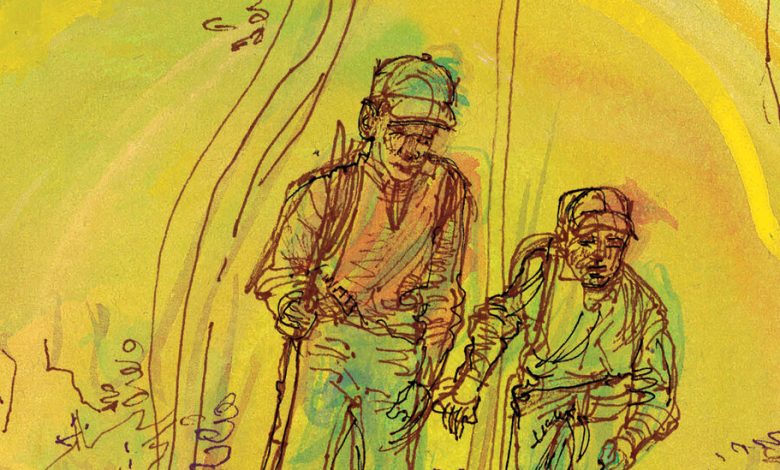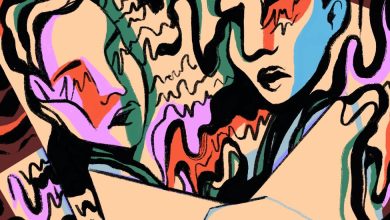Helping a Child Navigate Grief? Open a Picture Book.

“But where did he go?”
“Can she see us?”
“Why didn’t Pop bring his glasses?”
Kids have questions about death, and we don’t always have answers. In fact, we rarely do; we have questions of our own!
If you’ve ever been at the intersection of loss and “How am I supposed to explain this to someone in footie pajamas?,” you know how overwhelming it can be — like merging a tractor-trailer onto a six-lane highway when you only have your learner’s permit. And it’s rush hour. And you’re blindfolded. And you’re transporting a truckload of eggs.
“There are no words” might be all the rage in condolence cards, but there are words, and you can find them in these new picture books about grief. They aren’t the first ones to guide kids through the land of loss — we’ll always have classics like “Duck, Death and the Tulip,” by Wolf Erlbruch — but each of these stories has a depth and specificity that seem appropriate for a rising generation of readers who don’t remember a time before social distancing. Isn’t candor their birthright?
As for you, the one holding the book: You, too, might find solace in these simple, colorful and, yes, occasionally humorous tales. At the very least, they’ll give you a reason to sit next to a wriggly human heating pad whose breath smells like toothpaste. When you feel powerless, wordless and completely out of your depth, remember this: The sound of your voice might be the greatest comfort of all.
The following books are organized according to the loss they cover. Feel free to mix, match and connect the dots in a way that works for you.
Missing a Parent

From “A Walk in the Woods.”Credit…Jerry Pinkney and Brian Pinkney
“A Walk in the Woods,” by Nikki Grimes, Jerry Pinkney and Brian Pinkney
If you’re trying to explain the inexplicable, or at least provide a glimmer of hope, “A Walk in the Woods” is an excellent place to start. A week after his father’s funeral, a young boy follows the route on a map his dad left behind. It leads to the woods they once explored together, and then to a trove of sketches and poems and a note: “This last page is for you, Son. Draw and write your story. I’ll always be watching.” Not only is the story wise and heartfelt, but it also comes with a moving back story: After Jerry Pinkney died, his son completed the illustrations. This team wrote and drew what they knew, and it shows.
“Empty and Me: A Tale of Friendship and Loss,” by Azam Mahdavi. Illustrated by Maryam Tahmasebi. Translated by Parisa Sanraj.
A mother dies, and Empty — imagine the Pillsbury Dough Boy — takes her place. Empty accompanies a bereft daughter to school, towers over her while she eats a fried egg and tags along to an amusement park. The pair rescue a kitten together. They notice a flower blooming, the last one planted by the mother. Throughout Mahdavi’s book, snippets of prose appear in English and Persian, and they’re tiny in comparison with Sanraj’s elegant drawings. Slowly, the daughter gets used to the presence of her amiable, looming sidekick. She has no choice — and that, sadly, is the point.
“Mouseboat,” by Larissa Theule. Illustrated by Abigail Halpin.
“The wind is your voice.” So begins Theule’s spare tale about a girl trying to make sense of the world without her mother. Nothing is the same. Her father buys the wrong laundry soap and prepares weird meals. Her mom’s chair is empty. One blustery night, the girl sneaks away in the boat they built together — and there, in the middle of a storm-tossed lake, she finds the courage she needs. Bravery might not be the goal for every reader, but Theule shows how glimmers of connection can appear when and where you least expect them.
Missing a Sibling
“Where Did Benjamin Go?,” by Chris Clarkson. Illustrated by Annalise Barber.
The opening spread of this sensitively rendered story shows four hooks on a wall, labeled “Dad,” “Charlie,” “Ben” and “Mom.” Three of these hooks are laden with the usual front hallway flotsam: jackets, a bag, a hat. Ben’s is empty. Charlie, who appears to be around 6 years old, makes a list of everything he misses doing with his big brother: dolphin watching, snowflake catching, resting her head on his shoulder while he plays the piano. His parents miss Ben, too; they have their own lists. On the final page, the family gathers in a three-way hug, surrounded by memories of happier times. There’s no solution or quick fix for them; nor is there one in real life. Instead, Clarkson and Barber offer a reminder: You are not alone.
Missing a Grandparent
“I Wish I Could Tell You,” by Jean-François Sénéchal. Illustrated by Chiaki Okada.
If you’re looking for Grandparent Loss 101, “I Wish I Could Tell You” is the book to grab. Its sweetly old-fashioned illustrations might give the impression that you’ve wandered into a fairy tale, but the story packs a timeless and gracefully executed emotional wallop. A fetching little fox visits his grandmother, who smells like herself but somehow isn’t the bonny pink-shawled companion of forest strolls past. Then the elder fox is gone. On page after page, Sénéchal and Okada show the absence she leaves behind, and the majesty of the river and trees the little fox learned to love while he was by her side. The juxtaposition of the two is both devastating and triumphant.
“Maybe a Whale,” by Kristen Pendreigh. Illustrated by Crystal Smith
Like Theule in “Mouseboat,” Pendreigh has chosen a nautical theme. A girl and her mother set out on a kayaking trip to see whales beloved by a recently departed grandfather, but the creatures prove elusive — until, late at night, the pair hear humpbacks breathing in the bay, and the sound soothes them to sleep. Not only will this story remind readers of the unpredictability of life (the best laid plans can lead somewhere surprising), it also shows how grief can be an equalizer. The mother is sad, too; the girl tells us she hasn’t laughed in a long time. And there they are, working together to set up their tent and cook noodles for dinner. It’s a beautiful sight.
“Sylvester’s Letter,” by Matthew Burgess. Illustrated by Josh Cochran
“Some letters can’t be delivered in the usual way,” Sylvester informs us. So he enlists sky divers to land on top of a train headed to a jungle where a river packed with piranhas will carry his letter to a place where pink dolphins wait. From there, a messenger will pass it to a swarm of butterflies that will carry it “up, up, up … ” to Sylvester’s grandma. “Dear G.G.,” the letter begins, “I miss you every day. I always think of you when Mom puts a pickle on my plate — you being the most pickle-loving person I know.” We don’t need to be told the fate of Sylvester’s missive. On the last page he’s making his own pickles.
“The Remembering Stone,” by Carey Sookocheff
When her grandfather dies, a little girl clings to a “perfect” rock he gave her when he was teaching her to skip stones. Unfortunately, during Show and Share, the girl’s classmates don’t appreciate its significance. (Who can compete with new boots or a baby cousin?) Sookocheff’s calming story offers a powerful reminder about what we carry when we miss someone.
Making Sense of Pregnancy Loss
“Always Sisters: A Story of Loss and Love,” by Saira Mir. Illustrated by Shahrzad Maydani.
Raya can’t wait for her baby sister to be born. “Her name is Nura,” Raya tells us. “Mama says ‘Nura’ is Arabic for ‘beautiful light.’ She’s not here yet, but she’s already my little sunshine.” The sisters will run through the sprinkler together; they’ll play dress up and watch cartoons. After a checkup, Raya’s mother says that Nura won’t be coming home. While Mir, who is an OB-GYN, walks readers through the difficult conversations that follow, Maydani’s soothing chalk pastel and watercolor art keeps the pages turning. Hard as it is to imagine reading this one aloud, it’s even harder to imagine looking for such a book and discovering that it doesn’t exist.
“Because I Already Loved You,” by Andrée-Anne Cyr. Illustrated by Bérengère Delaporte.
A boy in solar system pajamas clutches a toy elephant while cheerily waving goodbye to his father and pregnant mother. They return with sad faces and stooped shoulders, and explain that the baby was stillborn. Cyr’s text speaks directly to the lost sibling: “I drew you a picture for when you’d come back”; “I gave my stuffie your name to remember you.” In an author’s note, Cyr writes, “I wanted to make sure that young readers understand that it’s normal to be sad, while also leaving them with a feeling of hope and love at the end of the story.”
Helpful Metaphors
“Grief Is An Elephant,” by Tamara Ellis Smith. Illustrated by Nancy Whitesides.
You’d be hard-pressed to find a story that states the facts as plainly as this one does, beginning with its title. In Smith’s telling, grief enters the world as an enormous beast and shrinks over time, from deer to fox to mouse to firefly. Try as her protagonist might, there’s no way to speed up the process. Some will quibble with the linear approach — sorrow has a way of ballooning back to elephant proportions at the oddest times — but you can’t beat this mantra: “Remember and wonder. Remember and miss. Remember and love.”

CreditCredit…
“The Swing,” by Britta Teckentrup
Teckentrup’s simple meditation unfolds through pictures of a pair of swings overlooking the water. For some, the swings are a place to fly; for others, they’re a serene spot to be alone or say goodbye. No matter the circumstances, the view is a constant, and even when the swings are tangled together or buried in weeds their frame is solid. Teckentrup’s illustrations contain multitudes, as do our dearest relationships. If you’re looking for a gift for a bereaved friend, “The Swing” is an excellent choice.
“Cape,” by Kevin Johnson. Illustrated by Kitt Thomas.
Before a funeral for someone he loved, a little boy gets a haircut and puts on a new suit. He also ties on a billowing red cape, believing it will protect him during one of the hardest days of his life. The boy isn’t slaying dragons or dueling with superheroes, but he guards his universe in a way that might be galvanizing for a young person caught in the glare of public mourning. “Memories make my swallow hurt,” he tells us. “I block them with my cape.” The boy will revisit happy moments on his own time.
Rituals
“Remembering,” by Xelena González. Illustrated by Adriana M. Garcia.
We’ve heard about the Rainbow Bridge. In her story about mourning a beloved dog, González refreshingly reframes end-of-life conversations about the beasts we love. A little girl corrals flowers, a tennis ball, a red leaf and a crooked stick to build an altar for Día de Muertos. The book ends with information about the celebration and guidance for building your own ofrenda. Be forewarned: Garcia knows how to draw a soulful pup. Even when viewed alongside higher-stakes losses, this one is a tear-jerker.
“Hamza Attends a Janaza,” by Shabana Hussain. Illustrated by Atefeh Mohammadzadeh.
“Although I attended many funerals as a child, all I remember is people being upset,” Hussain writes in an author’s note. Her gentle story shows Hamza’s much anticipated plan with his cousins being interrupted by the news that “Uncle Sameer with the sweet shop has died.” Hamza is not pleased, but then he remembers the red lollipop his uncle gave him during a visit. When his mother explains what will happen next — the prayers, the trip to a graveyard — the boy listens carefully. This book is geared toward Muslim children, but it contains a universal message about honor and respect.
It Will Get Better
“The Bear and the Wildcat,” by Kazumi Yumoto. Illustrated by Komako Sakai. Translated by Cathy Hirano.
“‘Yesterday I had no idea that today you would be dead!’ Bear cried. ‘If only I could go back to yesterday morning, I wouldn’t need anything else in the world.’” Poor Bear is mourning his bird friend, and his fellow woodland creatures say all the wrong things. (“It may be hard, but you have to forget about him.”) As Bear sets out for a solo adventure, happy memories come flooding back and tinges of pink begin to lighten Sakai’s haunting monochromatic pictures. Older readers will appreciate the wisdom here and younger ones will appreciate the peaceful “Frog and Toad” vibe.
“Flora’s Wish,” by Fiona Halliday
In Halliday’s vivid world, a mouse named Flora and a dandelion (called “Lion”) are the best of friends until, one day, Lion’s mane turns white and blows away; suddenly, he’s gone. Flora is confused, then lonely and sad. A scarecrow helps Flora gather her courage and, when she finally emerges from his pocket, she’s delighted to find a field of young dandelions. She knows Lion sent them. This one will appeal to “Wizard of Oz” fans and anyone who needs a reminder that wishes come true in unexpected ways.
“My Friend, Loonie,” by Nina LaCour. Illustrated by Ashling Lindsay.
Balloons are a recipe for heartache: They’re going to pop, float away or deflate. LaCour puts this sad fact to good use in her vivid book about a latex orb that insinuates itself into a little girl’s world only to depart, bobbing briskly into the sky. Neighborhood walks feel lonely; the mornings are quiet and gray. Eventually a yellow flower blooms in the yard, reminding the girl of “Loonie,” and things brighten again. Nothing gold can stay, of course, but beauty and friendship rebound.




